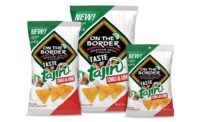Variety is the spice of life when it comes potato chips. While classic chips still own the lion’s share of the U.S. market, salty snack companies are offering new flavor combinations in a variety of packaging sizes. New flavors include spicy buffalo, hot BBQ and cauliflower, and many new offerings are gluten-free and Non-GMO Project verified.
Chips represent a robust market and the recent pandemic actually accelerated that growth, according to Anne-Marie Roerink, president of 210 Analytics LLC, San Antonio, TX. “The pandemic prompted more meal occasions to become at-home occasions. Also, more people worked from home and many kids were in virtual schooling. Those new patterns brought a host of opportunities for chips—classic potato chip, multi-grain chips and fruit chips.”
Chips producers deserve a lot of credit for innovation in taking advantage of this opportunity, Roerink adds. “We see brands play with limited-time offers to introduce new flavors and inspire unplanned purchases. We see innovation in package callouts, such as the addition of the ‘gluten-free’ label, whereas others are innovating with non-GMO, organic or vegan, which are big drivers of growth. Another area of innovation is package size and configuration.”
Market data
According to data from IRI, Chicago, for the 52 weeks ending May 16, 2021, the potato chips segment—the largest in the salty snacks category—was up 3.6 percent, with total sales of $8.3 billion.
Frito-Lay leads the category with nearly 60 percent market share. Its sales for the year hit $5 billion, up 4 percent. The company’s top two brands both saw growth, with Lay’s up 9.9 percent to $2.6 billion, and Ruffles up 5.9 percent to $1.1 billion. Baked Lays chips saw sales jump 169 percent to $63.5 million for the year.
Kellogg Co. is in second place, with $1 billion in sales and an increase of 10.8 percent. Its core Pringles brand grew 9.8 percent to $910 million, while the Pringles Grab & Go Stack brand held steady at $59.4 million and Pringles Snack Stacks grew 32.5 percent to $66.1 million.
Campbell Snacks saw growth for two of its top potato chip brands: Cape Cod grew 3.5 percent to $301 million and Kettle Brand grew 9.1 percent to $262.1 million. Utz saw its flagship potato chips grow 6.2 percent for the year, up to $313.2 million. The company’s Zapp’s brand grew 21.7 percent to $55.2 million.
The apple chips segment drew in $32.4 million in sales, with an increase of 14.5 percent. Bare Foods accounted for $20.6 million of those sales, with an increase of 12.8 percent. Seneca Foods brought in $10.7 million, with an increase of 23.4 percent. Greene Town Foods enjoyed a 12.4 percent increase to $320.7 million.
Looking back
Chips flavors introduced during the past year feature hot spice and other innovative combinations, which include spicy buffalo, hot BBQ and cauliflower.
PepsiCo Inc.’s Frito-Lay North America division partnered with NBA player Jayson Tatum to introduce a Ruffles potato chip flavor, Ruffles Flamin’ Hot BBQ. It combines a tangy barbecue flavor with Frito-Lay’s Flamin’ Hot kick. The flavor was inspired by Tatum’s hometown, St. Louis, which is known for its spicy barbecue.
Campbell Snacks made two big introductions: Kettle Brand: Krinkle Cut Truffle & Sea Salt, Krinkle Cut Habanero Lime, in Two New Variety Packs, and Cape Cod: New Variety Pack 16ct., Sour Cream and Onion Party Size 13oz. The chips are gluten-free and Non-GMO Project verified.
Kellogg Co. teamed with Xbox Game Studios and its Halo franchise to introduce spicy Pringles Wavy Moa Burger Crisps. The limited-edition Pringles flavor explores what a burger made from Moa (a bird-like creature from the game) might taste like, and features garlic, ginger, beef, chili pepper, and red pepper flavors.
REAL FOOD FROM THE GROUND UP, Fairfield, NJ, launched cauliflower chips in a spicy buffalo flavor. The chips are certified vegan, gluten-free and Non-GMO Project verified. “We’re excited about dipping into the potato chip category with a cauliflower-based version,” says Deb Holt, chief marketing officer. “We see cauliflower as our lead vegetable base and will keep innovating until there is a plant-based, cauliflower offering for each salty snack subcategory.”
Before COVID-19 shut down the economy, flavor was a growing trend in chips and the pandemic accelerated that growth, according to Michelle Reardon, spokesperson for Campbell Snacks, Camden, NJ. “While classic, core chips still represent the lion share of chip SKUs, flavored salty snacks outpaced unflavored growth. In addition, increased consumption, meaning larger pack types grew, as potato chips is an expandable category.”
Luke Mapp, president and CEO of Mikesell’s Snacks, Dayton, OH, says that, above and beyond flavor and ingredient trends in the salty snack aisle, he saw consumers seeking comfort foods—foods that could bring a small dose of happiness and familiarity. “During the past year, while many industries struggled, the grocery and club channels thrived. We were given an opportunity to build trust with our shoppers as we demonstrated to them that we were stable and weren’t going anywhere.”
During the past year, production of kettle-style potato chips continued to grow, and chip producers added considerable capacity in conventional potato chips as well, according to Don Giles, heat and control processing systems expert at Heat and Control, Hayward, CA. “On-machine seasoning has enabled snack producers to provide a variety of new products with minimal disruption to the production process; consequently, there has been big growth in the ‘small bag’ snack category.”
On the equipment side, automation (automatic case packing) expanded during the year, Giles adds. “Because many chip producers are struggling to hire qualified labor, a common trend is to identify where automation makes sense and where it provides the best ROI. Companies may have different metrics for determining payback, but the ones that leverage automation to benefit their supply chain are gaining market share.”
Looking forward
Reardon predicts that flavor will continue to be important in the coming year, but also expects texture and better-for-you alternatives to emerge as shoppers focus on wellness. “It’s going to be important to keep a pulse on the consumer to understand which pandemic-related behaviors are sticking and which are not. In the shorter term, we envision pent-up demand for summer social gatherings. We know chips often play a big role in those occasions, so it will be critical for brands to be top-of-mind and within arm’s reach.”
Mikesell’s Snacks plans to release throwback bags that will feature the company’s original packaging. “It’s the perfect time to embark on a project like this because it allows us to lean into what consumers are telling us: they’re interested in brands with heart and history behind them,” Mapp says. “Reintroducing our original packaging to today’s shoppers also allows us to more robustly tell our story on grocery shelves.”
On the equipment side, Giles says automation will allow chip producers to maximize their packaging output, which will help with small bag production. “Increased speeds for format bags and the ability to change over and run pillow bags quickly is important.” He adds that continuous potato chip processing systems are already available that minimize or eliminate the need to wash potato slices prior to frying, thereby saving on water usage.
On the chip ingredients side, many formulators are eliminating the use of antioxidants, which are often used with conventional oils when rancidity and off-flavors are a concern in order to transition towards a clean label, according to Dennis Strayer, a consultant with United Soybean Board, Chesterfield, MO. “Looking ahead, by converting from frying and spray oils with additives to high oleic soybean oil, formulators can increase shelf-life without the use of antioxidants.”
The better-for-you chip category will expand as consumers demand chips made with high-quality ingredients, which will give producers an opportunity to use healthier oils, adds Tyler Groeneveld, commercial grains and oils leader for North America, Corteva Agriscience, Wilmington, DE. The company develops oil seeds that supply healthy, high-stability oils for the food processing industry. “High stability oils enhance the healthfulness of foods while preserving key functional qualities such as clean taste, longer shelf life and clean labels.”
Looking ahead, Roerink predicts that chips producers will continue to lean on what they are known for: flavor and format innovation. She also predicts that chips will be linked to seasons such as Halloween. “Then there is a whole other level of innovation in the ingredients themselves, ranging from sweet potato chips and cauliflower chips to a variety of fruit-based chips. It’s all this combined innovation of ingredients, flavors, packaging, and merchandising that has made chips such an exciting area of growth in the past few years.”











